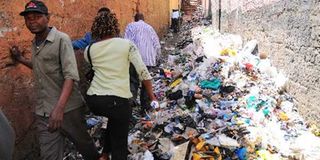Heaps of garbage chokes Nairobi city

Garbage pilling up off Kirinyaga Road in Nairobi city in this picture taken on December 28, 2015. PHOTO | JAMES EKWAM | NATION MEDIA GROUP
What you need to know:
- Mr Ondieki claimed that some of the contractors, who had their licenses withdrawn, are the ones dumping garbage in the backstreets.
- Some of the licensed companies are not collecting the solid waste and disposing it at Dandora dumpsite as required.
Garbage has started pilling up in several back streets in Nairobi after strategies City Hall had come up with, to streamline waste disposal management, failed to work.
The presence of the stinking waste in the city centre is now causing untold suffering to residents particularly owners of eateries who are warning of a health crisis if Dr Evans Kidero-led government does not address the problem urgently.
“We are back to the old days when backstreets were breading grounds for flies and hiding dens for streets families,” a hotel owner told the Nation saying they have lost customers since they cannot control the stench from the garbage.
Nairobi City County Executive for Environment Evans Ondieki also said the situation is getting out of hand.
“This is abnormal. It has never happened like that before,” he said in a telephone interview and blamed the whole mess on war between contractors City Hall had licensed to collect and dispose the solid waste in the Central Business District (CBD).
Mr Ondieki claimed that some of the contractors, who had their licenses withdrawn, are the ones dumping garbage in the backstreets and on sections of Juja Road, Kariokor and Wakulima markets.
A survey by the Nation on Monday established that some of the licensed companies are not collecting the solid waste and disposing it at Dandora dumpsite as required.
DUMPSITE
The story is the same in other areas in the city where garbage has been pilling for the last three weeks.
“Dandora dumpsite is no longer accessible. After collecting garbage we have to look for a safer place to dump it,” an employee of one of the licensed garbage collection firms in the CBD admitted.
Mr Odieki admitted that the Dandora dumpsite is no longer accessible due to poor roads and cartels, which have been demanding money from private garbage collection firms.
“There are cartels of criminal gangs who have been demanding Sh200 from contractors,” he said and blamed these cartels and the rogue contractors of sabotaging efforts that the governor, Dr Kidero has been trying to come up with to restructure solid waste management.
Waste and Environment Management Association of Kenya (Wemak), an umbrella organisation of companies involved in waste management business said City Hall should be blamed for the mess.
“Waste management has become a cash cow, which some senior officials in City Hall are using to make millions of shillings. All the methods they have been introducing to improve the garbage business have failed,” Wemak Chairman Samuel Onyancha said.
CITY HALL
Mr Ondieki said most of the 40 trucks City Hall bought recently purposely to collect and dispose garbage are grounded.
“We have recalled all these vehicles whether they have been repaired or not,” he said without giving further details.
According the governor, Nairobi generates about 2,400 tonnes of solid waste per day, which City Hall is unable to cope with.
One of the plans City Hall came up with to ease garbage collection was to divide the city into nine zones and give one company the monopoly to collect waste.
The plan was put on hold after Wemak went to court to challenge it.
Dandora dumpsite is full to capacity and plans to relocate it to Ruai was put on hold after experts warned that the proposed new site would affect the aviation industry.
This is because birds attracted to the dumpsite may hinder planes flying to and from Jomo Kenyatta International Airport.
Scientists led by a lecturer at the University of Nairobi's Department of Chemistry Prof Shem Wandiga have warned of increased air pollution in Nairobi if the dumpsite is not closed down.
They say it has reached its maximum life of 14 years and has become a major health threat to residents.





